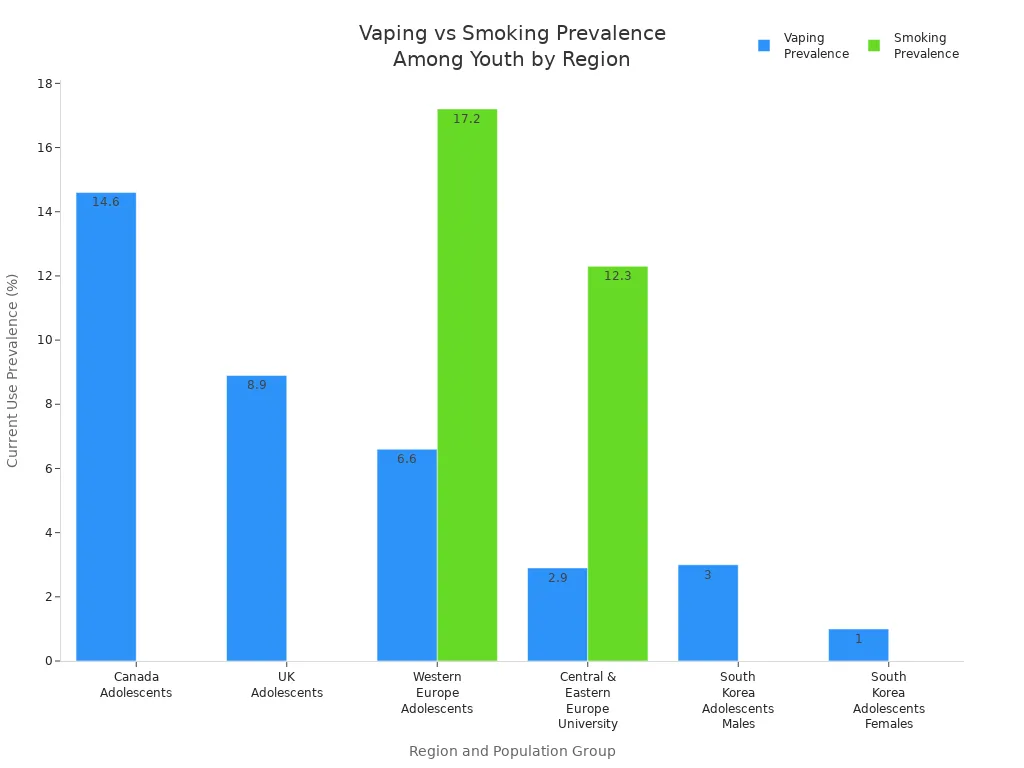How does vaping differ from smoking?

Vaping and smoking differ significantly in their methods and health implications. Vaping involves the use of battery-powered devices that heat e-liquids to create an aerosol for inhalation. In contrast, smoking involves burning tobacco, which produces smoke filled with harmful chemicals. Recent studies indicate that approximately 16.8% of young people globally have experimented with vape products, while over 1.3 billion individuals continue to smoke tobacco. This trend highlights the growing popularity of vaping among youth, even as smoking remains a major health concern worldwide.

Both vaping and smoking deliver nicotine, but vaping typically results in lower exposure compared to smoking. Understanding how vaping differs from smoking is crucial for individuals considering their options for nicotine use.
Key Takeaways
Vaping heats liquids to make vapor. Smoking burns tobacco to create smoke with many harmful chemicals.
Both vaping and smoking give nicotine. But vaping usually has fewer toxic substances and may cause fewer health problems.
Vaping can cause short-term breathing problems like coughing and chest tightness. Its long-term health effects are still unknown.
Cigarette smoke has thousands of harmful chemicals. Many of these cause cancer. E-cigarette vapor has fewer and different chemicals but still has risks.
Vaping may help some smokers quit by lowering cravings. But using both vaping and smoking together can raise health risks and nicotine dependence.
Health Effects of Vaping vs. Smoking

Short-term Health Effects
Vaping and smoking both have immediate health risks, but they show up in different ways. People who vape often say they have breathing problems, like:
Coughing and sore throat
Harder time breathing and weak lungs
Lower oxygen levels, especially in people with COPD
Faster heart rate and heart fluttering, especially with nicotine e-cigarettes
Studies show that vaping can cause stress and swelling in the body like smoking does, but with fewer harmful substances. Some breathing issues, like coughing and changes in airways, can happen without nicotine. Smokers with asthma or other breathing problems might feel worse after vaping. The CDC says that no tobacco product, including e-cigarettes, is safe, and research is still looking into the short-term health effects of vaping.
New users of vaping products often report breathing problems, such as:
Coughing
Trouble breathing
Tightness in the chest
Extra mucus
These problems often come from harmful chemicals in e-cigarettes, like vitamin E acetate. The CDC has noted serious cases of lung injuries linked to vaping, showing the possible dangers of using e-cigarettes.
Long-term Health Effects
The long-term health effects of vaping are not as clear as those of smoking. E-cigarettes might expose users to fewer harmful substances than regular cigarettes, but we still don’t know the long-term risks. Most evidence comes from short-term studies and animal tests, leaving us unsure about the long-term health effects of vaping.
There are not many studies comparing the long-term health effects of vaping and smoking. Some results suggest that vaping could lead to breathing diseases, like COPD and asthma, in just a few years. However, we still don’t know the risks for cancer and heart problems. On the other hand, the long-term dangers of smoking are well-known, including high chances of cancer, heart disease, and breathing illnesses.
Research shows that long-term vapers might have fewer breathing problems and better lung health than smokers. For example, some studies found that e-cigarette users had fewer COPD flare-ups and better health scores. But we need more research to be sure about these findings.
Regulatory groups like the FDA say that while e-cigarettes might be a safer choice for adult smokers, they still have risks. Switching completely from cigarettes to e-cigarettes is important to lower exposure to harmful chemicals. The FDA has approved some e-cigarette products after careful scientific checks, stressing the need for caution, especially for young people.
How Vaping Differs in Chemical Composition

Chemicals in Vaping
Vaping products have many chemicals, but they are very different from those in regular cigarettes. E-cigarettes mainly use glycerol and propylene glycol as a base, along with nicotine and flavors. The aerosol made when vaping has fewer harmful substances than cigarette smoke. Still, some studies show worrying elements in e-cigarette vapor.
Main chemicals found in disposable e-cigarette vapor include:
Metals like chromium, nickel, antimony, lead, zinc, and copper.
These metals can be in ionic forms, and some can cause cancer or harm the brain.
For example, nickel and antimony levels in vapor from some devices can be higher than safe limits for cancer risk.
Lead and nickel amounts exceed health risk limits for diseases besides cancer.
The presence of these dangerous metals raises serious health worries, especially since many young people use disposable e-cigarettes. While vaping may expose users to fewer toxic substances, it still has risks.
Chemicals in Smoking
Cigarette smoke is a complicated mix with over 9,500 compounds. More than 70 of these are known to cause cancer. The main chemicals in cigarette smoke include:
Hydrocarbons (like benzene and styrene)
Aromatic amines (like ortho-toluidine)
N-nitrosamines
Aldehydes
Inorganic compounds (like arsenic and cadmium)
The International Agency for Research on Cancer (IARC) has found 83 of these chemicals to be cancer-causing. The burning process during smoking creates many toxic substances, leading to serious health problems.
Aspect | Cigarette Smoke | E-cigarette Aerosol |
|---|---|---|
Number of identified compounds | Over 6,500 compounds | Between 94 and 139 compounds (flavored), 72–79 (unflavored) |
Major chemical components | Complex mix with many toxic substances | Mainly glycerol, propylene glycol, water, nicotine (~97%) |
Toxicant concentration reduction compared to cigarette smoke | N/A (baseline) | 68.5% to >99% reductions in priority toxicants |
Presence of combustion-related toxicants | Present | Mostly absent |
Regulatory recognized toxicants | 93 identified by FDA | Many FDA proposed HPHCs are absent |
The chemical complexity and many toxic substances in cigarette smoke lead to its higher health risks compared to vaping. Studies show that e-cigarettes produce much lower toxicant emissions—up to 99% less of the most harmful smoke toxicants—because there is no burning. However, vaping still has risks, including exposure to harmful chemicals like formaldehyde and diacetyl.
Nicotine Levels in Vaping and Smoking
Vaping Nicotine Concentration
Vaping products have different amounts of nicotine. Many well-known brands, like JUUL, have nicotine levels at or above 2% (20 mg/mL). In the U.S., JUUL pods can have up to 5% nicotine, which is about 40 mg per pod. This is similar to the nicotine in a pack of regular cigarettes.
Aspect | Details |
|---|---|
Average Nicotine Concentrations | Many popular brands, including JUUL, have products with nicotine levels at or above 2% (20 mg/mL). In England, rules limit nicotine to 20 mg/mL (2%), so JUUL products there have lower nicotine than in the USA and Canada. |
Variation by Country | - England: 12.8% of youth vapers use products ≥2% nicotine. |
Device Type and Nicotine Level | - Pod devices and nicotine salt products usually have higher nicotine levels and are used more often. |
A study in England found that daily e-cigarette users often like tank devices, which usually have more nicotine. Non-daily users often pick pods and disposables, which usually have less nicotine.
Smoking Nicotine Concentration
Regular cigarettes give about 1-2 mg of nicotine to the smoker. This amount can change based on the brand and how someone smokes. On the other hand, vaping can give much higher nicotine levels, especially with certain devices. For example, one JUUL pod can give nicotine like smoking a whole pack of cigarettes.
Smoking a cigarette usually means inhaling about 1-2 mg of nicotine.
Vaping nicotine is harder to measure exactly because it depends on the device and user.
A vape liquid with 20 mg/ml nicotine is about the same as the nicotine in a pack of cigarettes.
How nicotine is delivered also affects how fast users feel its effects. Nicotine from regular cigarettes is taken in quickly through the lungs, causing a fast nicotine 'rush.' Vaping sends nicotine through aerosol droplets, which means slower absorption. Things like device type, nicotine level, and how someone puffs affect this rate.
Even with lower nicotine delivery from vaping, users can still feel satisfied. Many say that vaping helps lessen withdrawal symptoms and cravings, showing that behavior also matters in the overall experience.
Vaping as a Cessation Tool
Benefits of Vaping for Quitting
Vaping can help people who want to stop smoking. Many smokers say e-cigarettes lower their cravings and withdrawal feelings. Some studies show that vaping might work better than regular nicotine replacement therapies (NRTs) like patches or gum. For example, one study found that 18% of people using e-cigarettes with support stopped smoking. In comparison, only 10% of those using NRTs quit.
Also, a survey of smokers who switched to vaping showed a 31% quit rate after six months. Heavy e-cigarette users had even better results, with 70% quitting smoking completely. These results suggest that vaping can help some smokers stop by giving them a satisfying choice while lowering their exposure to harmful chemicals.
Risks of Vaping for Quitting
Even with the possible benefits, vaping has risks that users need to think about. Many people use both e-cigarettes and cigarettes at the same time. This habit makes it harder to quit and can lead to more nicotine dependence. Research shows that people who use both often have similar levels of harmful substances as those who only smoke, which reduces the health benefits of switching to vaping.
Additionally, some studies say that vaping does not always lead to long-term quitting. One study found that only 2.8% of smokers who used e-cigarettes stayed nicotine-free for at least 12 months. This means that while vaping may help some people quit smoking, many still depend on nicotine from vaping or other products.
Vaping and smoking have different health risks. People who only use e-cigarettes usually say they feel healthier than those who only smoke. Studies show that people who do both vaping and smoking are more likely to feel stressed because they depend more on nicotine and are exposed to harmful chemicals. Health experts say it is important to quit both habits. Good ways to stop include counseling and nicotine replacement therapies. While vaping might help some smokers quit, it should not replace proven methods to stop. People should think about their choices carefully and get help to improve their health.
FAQ
What is the main difference between vaping and smoking?
Vaping heats e-liquids to make aerosol. Smoking burns tobacco. This main difference changes what people inhale and how it affects their health.
Is vaping safer than smoking?
Vaping usually exposes users to fewer harmful chemicals than smoking. But it still has health risks, and no tobacco product is completely safe.
Can vaping help people quit smoking?
Many smokers say vaping helps lessen cravings and withdrawal feelings. Some studies show it might work better than regular nicotine replacement therapies.
Are there any age restrictions for vaping?
Yes, most countries have age limits for buying vaping products. These limits are usually set at 18 or 21 years old. They aim to protect young people from nicotine addiction.
What are the common side effects of vaping?
Common side effects of vaping include coughing, throat irritation, and trouble breathing. Users might also get headaches and feel dizzy, especially with high nicotine levels.
